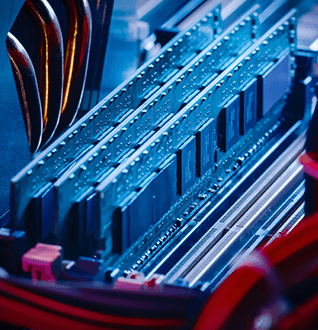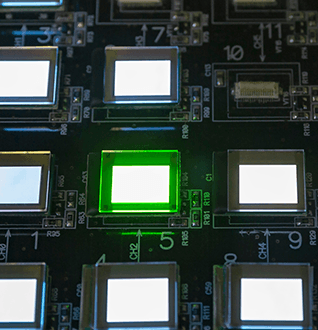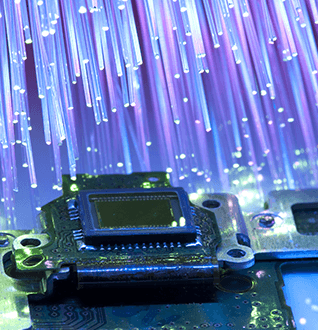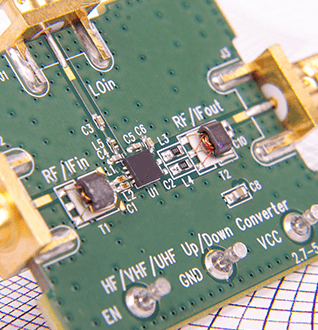The focus areas include developing next-generation high-speed, non-volatile memory and computing technologies, reliable technologies for fabrication of e-mode AllnN/GaN Fin MIS-HEMTs with high current drive, SNM shadow masks co-designed with differentiated CSS deposition process, technological advancements in three frontiers for optoelectronic applications, Programmable Photonic Integrated Circuits and Systems (CPPICS) and power-efficient precision delta-sigma converters, pipelined ADCs, etc.

Advanced Memory and Computing
The vision of the proposed Centre of Excellence on Advanced Memory and Computing (CAMAC) is to develop next-generation high-speed, non-volatile memory and computing technologies based on Phase Change Memory (PCM) and Resistive Random Access Memory (RRAM). This will enable the development of systems beyond the classical Von Neumann architecture to address the growing demand for massive data storage as well as faster processing in numerous applications including multimedia, computing, and Internet of Things (IoT) through an interdisciplinary approach by combining the expertise of materials science, physics, and engineering on advanced materials towards enabling next generation nanoelectronics devices for future computing.
Principal Investigator: Anbarasu Manivannan

Gallium Nitride Devices
In this project, we specifically aim to create enhancement-mode GaN devices suitable for applications in power switching and power amplifiers (PA). Presently, all PAs commercially available on the market for use in 5G systems are implemented with depletion-mode GaN devices, which require negative voltages for biasing. A majority of 5G systems (mobile or base station) only have unipolar supplies (positive voltage and ground). Therefore, each of these GaN power amplifiers requires an associated “bias controller” IC that generates the appropriate negative bias voltage. E-mode GaN devices will completely eliminate this requirement and boost the performance of the PA due to all associated circuitry on a single chip.
Principal Investigator: Amitava Das Gupta

OLED Display Technology
- Develop and demonstrate SNM shadow masks co-designed for use with our differentiated noveldeposition process;
- Develop an ultra-precision mask alignment system compatible with the AMOLED-CoE’s novel-AMOLED cluster system and our AMOLED fabrication flow. Only the emitter layers will be patterned with the SNM masks.
- Design and develop the building-block functional modules of the integrated silicon TFT backplanes using CMOS technology where the building-block modules include row and column drivers for the display section, the OLED drive circuits for the display area, video processors and gamma correction blocks, digital to analog conversion, timing controller blocks, on-chip temperature sensors etc.
Principal Investigator: Debdutta Ray

Optoelectronic Carbon Nanostructures
The CoE aims to initiate a consolidated effort towards using the research level know-hows on carbon nanostructures towards developing optoelectronic devices with state-of-the-art features competing with popular semiconductor-based devices. This involves research on carbon dots as emitters for OLEDs and graphene-based interconnects and electrodes for flexible optoelectronics, including multifunctionality of serving as a humidity-protective coating. Apart from working towards technological advancement, this proposal also offers scope for fundamental studies of optical properties, like luminescence, of carbon nanostructures.
Principal Investigator: Jayeeta Bhattacharyya

Photonic Integrated Circuits
The ultimate aim of this proposal is to establish a world class Centre for Programmable Photonic Integrated Circuits and Systems (CPPICS) within a span of five years duration of the project (Phase-I and II). Within the scope of this proposal, we aim to demonstrate a working prototype of FPPGA core which can be useful in both microwave photonics and quantum photonics applications as short-term goals of the proposed CPPICS.
To be more specific, the proposed FPPGA core will be packaged with electronic/optoelectronic peripherals and subsequently standardized for the following two applications:
- Reconfigurable RF Filter and Tunable RF sources for RADAR/5G applications and
- Quantum key generation and distribution with heralded single photon sources. The efforts will be then further extended to demonstrate a universal FPPGA core which can be useful in all application areas by reducing ASPICs as many numbers as possible.
Principal Investigator: Bijoy Krishna Das

RF, Analog and Mixed Signal Integrated Circuits
Analog, RF, and mixed-signal ICs form the basis for converting real-world signals into digital form, and storing, processing and transporting these signals. Scaling of semiconductor technology throws new challenges and opportunities at circuit designers. Cases in point are the emergence of new communication standards (5G) that demand the integration of multiple RF transceivers on a chip in a power- and area- efficient manner, the problem of transporting data at several 10s of Gbps in data centers in a power and area efficient manner, and the need for implementing low-power inference engines used in AI/ML algorithms. CERAMIC will pursue cutting-edge research in the following verticals - data-conversion, high-speed serial links (SERDES), and RF. Each of these is a vast area in itself, and it is necessary to focus on specific problems in order to make an impact.
Principal Investigator: Shanthi Pavan

